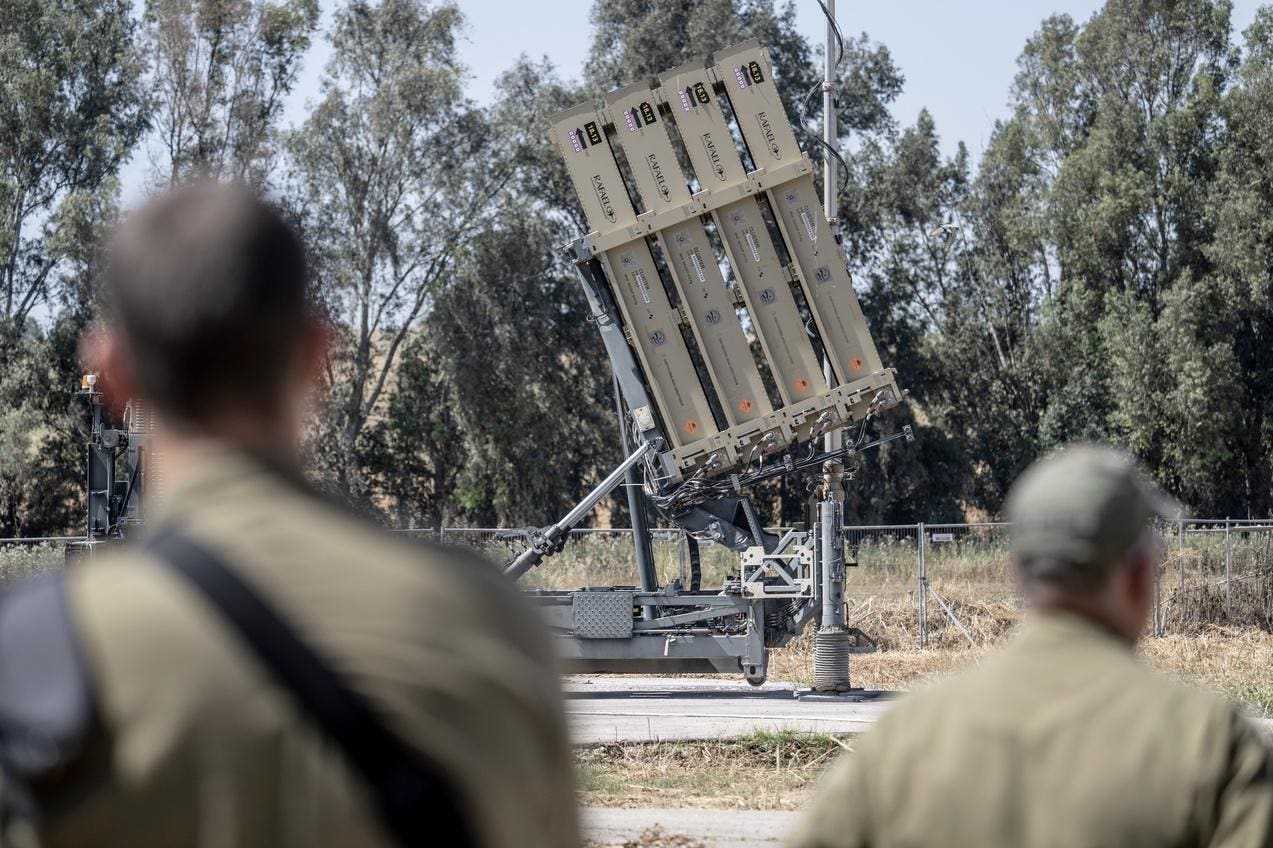U.S. President Joe Biden announced the halt of some arms shipments to Israel that could be used for the operation in southern Gaza’s Rafah but underlined that this does not include arms used solely for defensive purposes, such as the Iron Dome air defense system. While the announcement certainly marks a low point in U.S.-Israel relations, it’s worth remembering America sold only defensive weaponry to Israel in the past and was even hesitant to sell it any heavy weapons at one stage.
“We’re going to continue to make sure Israel is secure in terms of Iron Dome and their ability to respond to attacks that came out of the Middle East recently,” Biden told CNN on Wednesday. “But it’s, it’s just wrong. We’re not going to – we’re not going to supply the weapons and artillery shells.”
The U.S. has already paused a shipment of 3,500 2,000-pound and 500-pound bombs.
Biden also stressed the U.S. isn’t “walking away from Israel’s security” but is “walking away from Israel’s ability to wage war in these areas.”
In the early years of Israel’s existence, the U.S. was hesitant to arm it directly, especially with heavy weapons. It ruled out any supply of offensive military hardware. Former Israeli Prime Minister Shimon Peres once lamented that the Truman administration refused even to sell rifles to Israel.
The U.S. rejected an Israeli request for tanks and artillery in 1950, citing Western Europe’s need for such hardware. In 1955, Israel proposed purchasing $50 million of American fighter jets and tanks. While the Pentagon approved most of its requests, then-Secretary of State John Foster Dulles opposed the sale.
Israel would only start receiving significant quantities of American arms in the 1960s, beginning with the Kennedy administration.
In 1962, the U.S. approved the sale of MIM-23 Hawk air defense missiles, acknowledging that Israel needed advanced weapons to maintain a balance against its larger, Soviet-equipped neighbors. It marked the first time the U.S. proved willing to sell heavy weapons to Israel, although these were purely defensive.
In those days, the Israeli military preferred developing powerful offensive capabilities, believing its ability to take the battle to enemy territory was far more critical than defending against enemy attacks. Therefore, there was significant skepticism in the Israeli military leadership over the Hawk purchase. They feared possessing such purely defensive systems would give Israel’s political leadership an excuse to avoid mounting risky but necessary offensive operations.
In a landmark deal reached in 1965, the United States, by then under the Johnson administration, agreed to sell Israel 210 M-48 Patton tanks.
“Unlike the Hawk missile, a strictly defensive weapon that could only be employed to protect air bases and other sensitive targets within Israel, the M-48 could be used in offensive warfare, to strike deep into Arab territory,” noted one retrospective analysis examining the historical significance of the sale.
Washington agreed to sell Israel A-4 Skyhawk light attack aircraft the following year.
After the June 1967 war, when Israel captured the Sinai Peninsula from Egypt and the Golan Heights from Syria, the United States replaced France as Israel’s primary arms supplier. In November 1968, the Johnson administration agreed to a landmark sale of 50 F-4 Phantom II fighter-bombers, an aircraft more advanced than those in the Arab air forces.
During the 1973 Arab-Israeli War, when Egypt and Syria simultaneously attacked Israel to reclaim the Sinai Peninsula and Golan Heights, the Nixon administration not only supported Israel, it airlifted fighter jets and tanks in Operation Nickel Grass to replenish Israel’s battlefield losses.
The subsequent 1979 Egypt-Israel peace agreement saw the U.S. commit to providing the two countries with billions worth of military aid each year, which has continued to the present day.
Underscoring its determination to maintain a robust offensive capability, Israel opted to acquire the F-15 Eagle in the 1970s after determining it could serve as an effective strike aircraft. It was an intriguing decision. The U.S. Air Force initially saw the F-15 serving exclusively as an air superiority rather than a multirole fighter, summing it up with the catchy motto: “Not a pound for air-to-ground.”
Israel had other ideas for its Eagles. The then-Defense Minister Shimon Peres had the military conduct a feasibility study to determine if the F-15 could fly to the Bab-el-Mandeb strait and back without in-flight refueling. The Israeli military concluded it could while carrying two bombs.
“This was enough to convince the government to buy the world’s best air superiority fighter, based on the jet’s air-to-ground attack potential!” recounted a detailed book on Israeli F-15s.
Israel would also receive its first F-16s in 1980.
In the late 1970s and early 1980s, it was Israel opposing U.S. arms sales to Saudi Arabia. Israel was reluctant to accept the Carter administration’s reassurances about its sale of F-15s to the kingdom. The administration did its utmost to reassure Israel and its backers, stressing the fighters would not be based near Israel and wouldn’t have conformal fuel tanks extending operational range.
In the early years of the Reagan administration, Israel would also protest the sale of E-3 Sentry airborne early warning and control aircraft, fearing they could compromise Israel’s ability to launch another surprise attack like in 1967. The sale went ahead regardless.
(By the late 1990s, it was the turn of the United States to oppose an Israeli sale of a similar system, the Phalcon, to China. Beijing had no such capability when it reached out to the Israelis in 1996, and Washington feared the Israeli system would give China a vital technological advantage over Taiwan. American objections successfully compelled Israel to cancel that deal in July 2000.)
In June 1981, Israel bombed Iraq’s Osirak reactor using its newly acquired F-15 and F-16 jets. The Reagan strongly criticizing Israel, claiming the strike was not in self-defense and violated the terms under which it sold Israel those advanced aircraft. The following year, the administration imposed a six-year ban on the sale of cluster bombs to Israel in protest over their use during Israel’s war in Lebanon.
Israeli skepticism over the value of purely defensive weaponry re-emerged in 1991. After Saddam Hussein’s Iraq invaded Kuwait the previous year, the United States assembled a multinational coalition that included Arab states. The U.S. did not want Israel to intervene in the war for fear it would compel those Arab states to withdraw from the coalition and fragment it at a critical moment.
Washington sent MIM-104 Patriot missiles to help defend Israel against attack. Iraq did ultimately fire over 40 Scud missiles at Israel during the ensuing Persian Gulf War. While these Scud missiles failed to kill large numbers of Israelis, Israel was utterly dissatisfied with the Patriot, estimating it shot down a single Scud missile, if any.
Israel later only used the Patriot against drones and a Su-24 bomber coming from Syria in the 2010s. It ultimately decided to mothball all its Patriot batteries this May, less than a month after Iran launched an unprecedented barrage of over 300 drones and missiles against it.
American funding helped Israel develop the much more advanced Arrow series of anti-ballistic missile missiles. The Arrow 3 can even intercept ballistic missiles above the Earth’s atmosphere, which it proved capable of for the first time in combat against a Houthi missile fired at Israel from Yemen in November 2023.
But even when the Arrow was under development, skeptics questioned whether the cost outweighed any benefits, wondering if it was actually undermining Israel’s offensive capabilities designed for preventively thwarting any missile attack in the first place. Such skepticism strongly echoed that of the Israeli military leadership in the 1960s regarding the Hawk acquisition.
Even when Israeli defense systems proved their capabilities, they were still met with skepticism.
Israel’s vaunted Iron Dome system has shot down thousands of short-range rockets fired by Hamas from the Gaza Strip during the repeated flare-ups and wars since 2012. Writing in 2014, when Israel fought its longest war against Hamas until the present conflict, Israeli historian Benny Morris argued the Iron Dome “precisely because of its effectiveness, has been disastrous for Israel.”
During that war, the Iron Dome, facing its most significant combat test hitherto, had an estimated 90 percent success rate. Had there been no Iron Dome, Morris argued, the casualties and damage caused by rockets would have compelled any Israeli government to order an enormous ground offensive to destroy Hamas rather than degrade it through airstrikes and limited ground incursions.
“Iron Dome has ‘saved’ the Israeli government from launching such a massive ground assault,” Morris wrote, again echoing the kind of criticism and skepticism expressed over the Hawk procurement 50 years earlier.
Israel’s multilayered air defenses successfully intercepted the overwhelming majority of Iran’s missiles on April 13—while the U.S., France, and Jordan helped intercept the drones before they reached Israeli airspace. Biden told Israeli Prime Minister Benjamin Netanyahu shortly after the attack that the U.S. would not support any Israeli retaliation against Iran, advising him to “Take the win.”
However, with members of Netanyahu’s government having called for a large-scale retaliation and even publicly mocking Israel’s April 19 strike on Isfahan, it’s clear a substantial number of Israelis continue to feel hamstrung by their state-of-the-art defensive weaponry rather than reassured and secure.
Read the full article here





